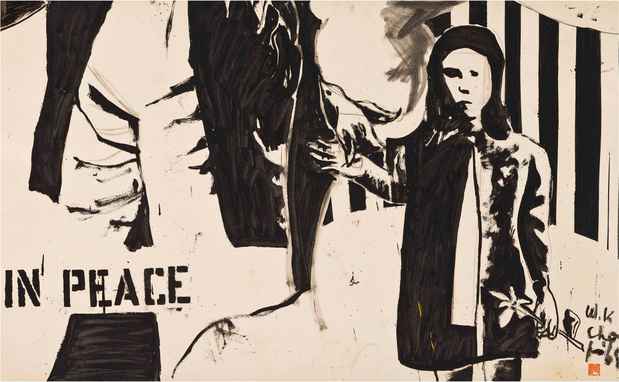Wook-Kyung Choi Exhibition
Tina Kim Gallery

[Image: Wook-Kyung Choi "Untitled" (Year unknown) Acrylic on canvas 44.09 x 56.69 in.]
This event has ended.
Tina Kim Gallery presents a solo exhibition of works by Wook-Kyung Choi (1940-1985). The exhibition focuses both on Choi’s collage works and better known abstract paintings—mostly produced in the late 1960s. Rooted in her study of Abstract Expressionism, Choi rejected the traditional abstract language of form and color, instead using an expressionistic style as a device for engaging with the external world. Characterized by tremendous energy, her works on paper and canvas reveal a unique artist who juxtaposed formal themes with a vocabulary of found imagery to explore her own Korean identity and sense of displacement while living in the US during the 1960s. Returned to Korea in 1978, she struggled to make her own particular style with unique and colorful abstract paintings amidst dominant Korean artistic movements such as Dansaekhwa.
Wook-Kyung Choi began to produce her collages in the late 1960s. Reflecting the influence of Robert Rauschenberg’s Combine Painting as well as Pop Art, her use of collage reflects Choi’s curiosity and intellectual engagement with popular media alongside her interest in experimenting with materials. For example in one of the untitled works located in the third gallery, the artist has glued cut magazines and papers in dynamic and abstract ways, then used acrylic and ink paint to further accentuate the visual relationships. Her use of appropriated language and imagery do not deliver a specific message, yet her repeated use of woman suggests a keen concern with sexism and the role of female artists. The symbolic significance of her collage works exceeds her interest in cultural critique and appropriation of pop idioms. For Choi, the combination of formal mark making with popular print mediums activated her work allowing both her and her viewers to become socially and politically engaged.
Raised in Korea when the trauma of WWII and the Cold War was still omnipresent, her collages bluntly confront these and other social/political issues such as racism, poverty, violence, and sexism. And Choi’s use of collage functions to balance the past and present, as well as reflects her own deeply personal story as a Korean artist living in America. In this respect, her works allow a rare window into Choi’s personal life story as well as her poignant response to the charged social milieu of the 1960s. Choi’s artistic style and practice varied greatly, reflecting both her intellectual curiosity and political awakening. Inspired not only by Abstract Expressionism but also Art Informel, Chois’s works all share a consistency in their attempt to balance the relationship between formal composition —characterized by her use of highly gestural and thick brushwork—and social critique. Sometimes form and color are arranged mathematically, and other times more amorphously. The development of Choi’s oeuvre was not chronological, and her practice did not follow a clear trajectory, instead hewed to her personal evolution and commitment to activism. Despite this insistence on experimentation and the personal, Choi developed a clearly articulated signature style marked by a command of formal gestures and materials. This integration of traditional painting styles and history provided a platform on which her vision was articulated, a vision that boldly transcended the vast cultural and historical differences between South Korea and the United States.
Born in Seoul, Korea in 1940, Wook-Kyung Choi graduated from the College of Fine Arts at Seoul National University in 1963. Shortly after, Choi moved to the United States to expand her education as well as artistic career, studying at the Cranbrook Academy of Art and receiving her MA in Fine Arts from the Brooklyn Museum School of Art. From 1968 to 1971, Choi taught painting at Franklin Pierce College as an Assistant Professor. She continued her career as an artist and professor after she returned to Korea in 1978, teaching at Yeungnam University and later at Duksung Women’s University. Throughout her short yet prolific artistic career until her death at the age of 45, she was most known for her association with Abstract Expressionism and Pop Art which were the main movements in the United States at the time. The influence of these schools distinguished her from other Korean artists and the dominant contemporary groups at the time such as Korean Avant-garde who worked with performance and installation and Dansaekhwa. Choi’s challenge to the orthodoxy of the Korean art scene came in many different forms: abstract paintings, ink drawings, paper collages, and figure drawings. Solo exhibitions of the artist have been held at Kukje Gallery, Seoul (2016); Gana Art Center, Seoul (2013), The National Museum of Contemporary Art, Gwacheon, Korea (1987); Roswell Museum, Roswell, Mexico (1977); and Shinsegye Art Gallery, Seoul (1976). Choi’s work is included in the collection of the Missouri State University, Kansas, Missouri; Skowhegan School Foundation, New York; Skowhegan School of Painting and Sculpture, Mural, Skowhegan, Maine; Colby College of Art Museum, Watervile, Maine; National Museum of Modern and Contemporary Art, Gawcheon, Korea; Seoul National University, Seoul; Duksung Women’s University, Seoul; Christian Academy House, Seoul; Wooyang Art Museum, Gyeongju, Korea; Leeum Samsung Museum of Art, Seoul; and Hasol Art Museum, Wonju, Korea.
Media
Schedule
from September 14, 2017 to October 21, 2017
Opening Reception on 2017-09-28 from 18:00 to 20:00